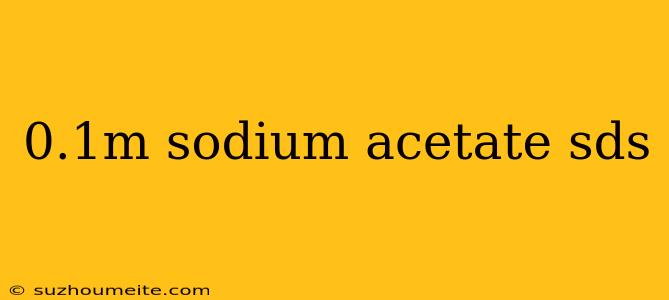0.1M Sodium Acetate SDS: Safety Data Sheet Overview
Introduction
Sodium acetate, also known as sodium ethanoate, is a commonly used laboratory reagent and pharmaceutical intermediate. A 0.1M sodium acetate solution is a diluted form of the chemical, which is often used in molecular biology, biochemistry, and pharmaceutical applications. As with any chemical substance, it is essential to handle 0.1M sodium acetate with caution and adhere to safety guidelines to minimize risks. This article provides an overview of the Safety Data Sheet (SDS) for 0.1M sodium acetate.
Identification
- Product Name: Sodium Acetate Solution (0.1M)
- CAS Number: 127-09-3
- Molecular Formula: CH₃COONa
- Molecular Weight: 82.03 g/mol
Hazards Identification
Physical Hazards
- Flammable: No
- Explosive: No
Health Hazards
- Acute Toxicity: May cause skin and eye irritation. Ingestion may cause gastrointestinal irritation.
- Skin Corrosion/Irritation: May cause skin irritation, especially if the solution is concentrated.
- Eye Damage/Irritation: May cause eye irritation.
- Respiratory Sensitization: No
- Skin Sensitization: No
Environmental Hazards
- Environmental Toxicity: Not expected to be hazardous to the environment.
First Aid Measures
Skin Contact
- Immediately flush skin with plenty of water.
- Remove contaminated clothing and shoes.
- Wash skin with soap and water.
Eye Contact
- Immediately flush eyes with plenty of water.
- Remove contact lenses, if present.
- Continue rinsing for at least 15 minutes.
Ingestion
- Never give anything by mouth to an unconscious person.
- Rinse mouth with water.
- Give water to drink if conscious.
Accidental Release Measures
- Contain spill and prevent further leakage if safe to do so.
- Wear personal protective equipment (PPE) as specified in Section 8.
- Neutralize spill with acid or base, if necessary.
- Dispose of waste according to local regulations.
Handling and Storage
Handling
- Handle in a well-ventilated area.
- Avoid contact with skin, eyes, and clothing.
- Wear PPE as specified in Section 8.
Storage
- Store in a cool, well-ventilated area.
- Keep away from incompatible materials.
- Keep container tightly closed.
Exposure Controls/Personal Protection
Exposure Limits
- Not applicable.
Personal Protective Equipment (PPE)
- Wear protective gloves.
- Wear protective clothing.
- Wear eye protection.
- Wear respiratory protection if airborne concentrations exceed the exposure limit.
Physical and Chemical Properties
Physical Properties
- Appearance: Colorless liquid
- Odor: Slight acetic acid odor
- pH: 7-8
Chemical Properties
- Stability: Stable under normal storage conditions.
- Reactivity: Reacts with strong acids to form acetic acid.
Stability and Reactivity
Stability
- Stable under normal storage conditions.
Reactivity
- Reacts with strong acids to form acetic acid.
Toxicological Information
Acute Toxicity
- Oral: LD50 (rat) > 2000 mg/kg
- Dermal: LD50 (rabbit) > 2000 mg/kg
- Inhalation: LC50 (rat) > 2000 ppm
Chronic Toxicity
- Not applicable.
Carcinogenicity
- Not classified as a carcinogen.
Reproductive Toxicity
- Not classified as a reproductive toxicant.
Mutagenicity
- Not classified as a mutagen.
Ecological Information
Environmental Toxicity
- Not expected to be hazardous to the environment.
Disposal Considerations
- Dispose of waste according to local regulations.
Transport Information
- Not applicable.
Regulatory Information
OSHA Hazards
- Not classified as a hazardous substance.
EPA Hazards
- Not classified as a hazardous substance.
This Safety Data Sheet provides a comprehensive overview of the hazards associated with 0.1M sodium acetate and outlines recommended safety measures to minimize risks. Always handle this chemical substance with caution and follow laboratory safety guidelines.
